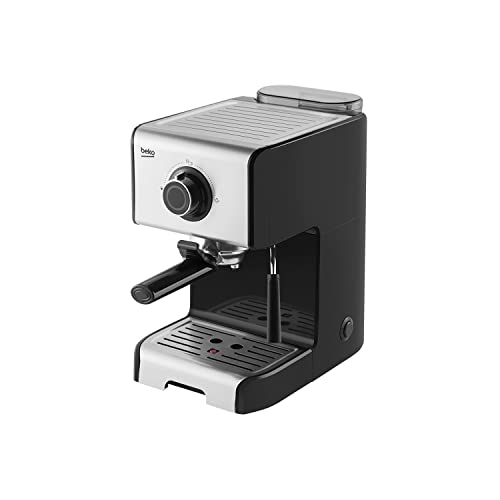How Does Machine Espresso Work?
Machine espresso uses precision pressure and mind-blowing filter technology to make the delicious coffee we enjoy. How does it work exactly?
Espresso is created by forcing hot water under high pressure through finely-ground coffee. The process is similar to making drip coffee but the key difference is in the pressure.

The Group Head
The name implies, the group head is the place you place your portafilter while making espresso. It is responsible for dispersing the water into the portafilter before controlling the pressure of the resulting extraction. There are a variety of types of group head each with its own advantages and drawbacks. Some are designed to provide temperature stability while others are designed to handle pre-infusion. Others are built to control the lever. Some have a combination, like the E61. This is a popular choice among baristas since it provides multiple advantages in one package.
As you can see in the picture above, the group head is fitted with several notches. You can place your portafilter in these notches and then turn the head around to secure it. A gasket made of rubber is placed in the notches to create a seal while you insert your portafilter. The notches on the head allow for a precise positioning of the portafilter which is crucial to ensure an even extraction.
Aside from allowing you to easily place your portafilter in, the group head is responsible for maintaining a consistent temperature. This is achieved by cycling hot water around the portafilter and through the brew-basket, making sure that the temperature is always at the right level for extraction. It is important to remember that even a tiny deviation can make the difference between a great and a great espresso.
espresso machines uk used in rotary espresso machines supply the nine atmospheric bar pressure needed for espresso extraction. This differs from manually operated piston machines that employ levers. The pressure builds up by drawing tap water from a reservoir and pumping it through a heat exchanger prior to being pushed through the ground coffee in the group head.
Pumps tend to be less expensive than piston-driven machines, and they tend to last longer, but both types of machines could be damaged by excessive use and inadequate cleaning. They also add mechanical complexity which can result in costly prices for even the most basic models.
Certain espresso machines eliminate the pump entirely and make use of steam pressure to make espresso. The drawback of this is that the same boiler that produces steam also raises the temperature of water to the point of boiling which can cause over-extraction. In addition, these machines frequently have to restore their pressure between cups, which requires time and energy.
Many espresso machines employ either a rotary or vibration pump, with a vibration model that uses a vibrating disc to generate the pressure and rotating models that push hot water through the grounds under high speed. Both types of machines can produce an excellent espresso, however the rotary pumps are quieter, and more durable than vibration pumps.
The Boiler
The boiler is what makes the water warm to the perfect temperature for extraction. The resulting steam reaches the portafilter that contains ground espresso beans and is then pumped down into the cup. The steam causes enough pressure to push the grounds of the coffee through. This creates a layer crema that is then poured over. This is one of the main characteristics of a great espresso.
There are three distinct types of espresso machines, each with different pumps and the temperature of the brew. There are many ways to control the brew and the size of cup that can be made by the machine.
The first espresso machines were steam-type. They had one boiler to make both steam and brew but the pressure they could generate was low - only two bars of atmospheric pressure at the most. The coffee tasted bitter and burnt. The modern espresso machine was developed by the Milanese producers Luigi Bezzerra & Desiderio Pavoni.
The most popular espresso machine is a semiautomatic that has an electric pump. When people think of espresso machines, they picture these machines. With a semi-automatic machine you have to grind the beans and tamp them by hand, but the pump is able to regulate the flow of water and pressure. This is an excellent solution that combines human control with mechanized reliability.
The Filter
Espresso machines typically have a filter that separates the grounds of the coffee from the hot water. The filter is also an essential element of the machine's temperature control, as it prevents overheating.
It also improves flavor, as a filter allows for a longer bloom time. This lets the beans release their nuances, and allows for better extraction.
However it is crucial to remember that even a high-quality filter can result in a poor cup of coffee, since the quality of the beans and extraction is still important.
It's in this area that the magic takes place. This is the reason why espresso tastes so delicious. The grouphead, often called the brew head, is the place where the portafilter (the thing you put the ground coffee in) is placed when you're making espresso.
Steam-driven espresso machines make use of hot water heated in an airtight container to produce steam. The steam then pushes hot water through grounds of coffee at high pressure. They are less expensive and easier to maintain than pumps-driven models. However, they are limited in their ability to create the perfect brewing conditions because they operate at 1-1.5 bars of pressure. The perfect shot requires 9-10 bar.
In recent times, espresso machines powered by compressed air-pump are becoming increasingly popular. They utilize an air compressor to force hot water into the grounds and are more portable than electric steam-driven machines.
